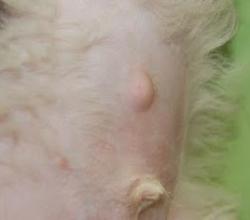 Umbilical hernias are usually painless and typically do not cause any long-term issues as the puppy grows into an adult. Most umbilical hernias pose no health threats. While the exact incidence and causes are unknown, if certain “family” lines have a higher incidence of umbilical hernias, this may suggest at least a partial genetic predisposition to the condition.
Umbilical hernias are usually painless and typically do not cause any long-term issues as the puppy grows into an adult. Most umbilical hernias pose no health threats. While the exact incidence and causes are unknown, if certain “family” lines have a higher incidence of umbilical hernias, this may suggest at least a partial genetic predisposition to the condition.
What Exactly Is an Umbilical Hernia?
In an unborn puppy, the umbilicus slips out through an opening in the puppy’s stomach wall to connect to the placenta. When a puppy is born, his dam chews or breaks this umbilical cord, or we, the breeder, will cut and tie it off. It dries and shrivels up, leaving behind the “belly button.”
Generally, the abdominal wall closes up in the young puppy, leaving a solid abdomen. Sometimes a small bit of fat may get stuck in the opening, which leaves an “outie” belly button. Occasionally, the wall of the abdomen simply does not close all the way. That is when we say a puppy or dog has an umbilical hernia.
Signs Your Dog Has an Umbilical Hernia
If your dog has an umbilical hernia, when your dog lies on his back, you can feel a small opening at the umbilicus site. If it is the size of the end of your pinkie finger at eight weeks of age, it is usually not a problem. Many of these small hernias will close up on their own by six months of age.
If the hernia bubbles out or is bigger than a pinkie finger, there is a chance that the intestines may be slipping in and out of the opening. At some point, a section of the intestines could slide out through the hernia opening and get trapped or twisted. At that point, your dog needs emergency surgery.
Signs you see with trapped intestines can include pain, your dog standing stiffly with his back arched, and possibly not eating or vomiting. If you see these symptoms, you need to call your veterinarian right away.
How to Treat a Dog Umbilical Hernia
Many small hernias will close on their own within six months. Larger hernias will require surgery to close up the opening, leaving the intestines safely inside. If your puppy is not having any problems, your vet may recommend keeping an eye on it and doing the surgery at the same time as spaying or neutering. That means one bout of anesthesia and recovery for your pet and less cost for you.
If intestines become trapped at any point, immediate emergency surgery is necessary.
Some people have tried to encourage the closure of hernias by using a belly wrap on their puppies with hernias. The goal is to keep all tissues (fat, intestines, etc.) in the abdomen so the opening can heal without interference. This is generally not successful but does help in some cases. We suggest discussing this with your veterinarian during your puppy’s “well visit” to determine the best course of treatment.
Luckily, most umbilical hernias are small and don’t present a health concern for your dog!